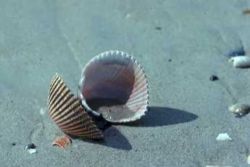Cockle
Cockles are a group of (mostly) small, edible, saltwater clams. They are marine bivalve molluscs in the family Cardiidae.
| Cockle | |
|---|---|

| |
| Live specimens from France | |
| Scientific classification | |
| Kingdom: | |
| Phylum: | |
| Class: | |
| Order: | |
| Superfamily: | |
| Family: | Cardiidae Lamarck, 1809
|

They are very common on sandy sheltered beaches throughout the world. The distinctive rounded shells of cockles are symmetrical, and are heart-shaped when viewed from the end. In most genera there are numerous radial ribs (ridges on the shell). The genus Laevicardium, the egg cockles, have very smooth shells.
The mantle has three openings (inhalant, exhalant, and pedal) for siphoning water and for the foot to stick out. Cockles are capable of 'jumping' by bending and straightening the foot. Cockles burrow using the foot, and feed by filtering plankton from the surrounding water. Some species reach maturity quickly.[1]
Confusingly, the common name "cockle" is also given (by seafood sellers) to a number of other small edible bivalves which have a somewhat similar shape, however these bivalves are in other families such as the Veneridae (Venus clams) and the Arcidae (ark clams). Cockles in the family Cardiidae are sometimes known as "true cockles" in order to distinguish them from these other species.
